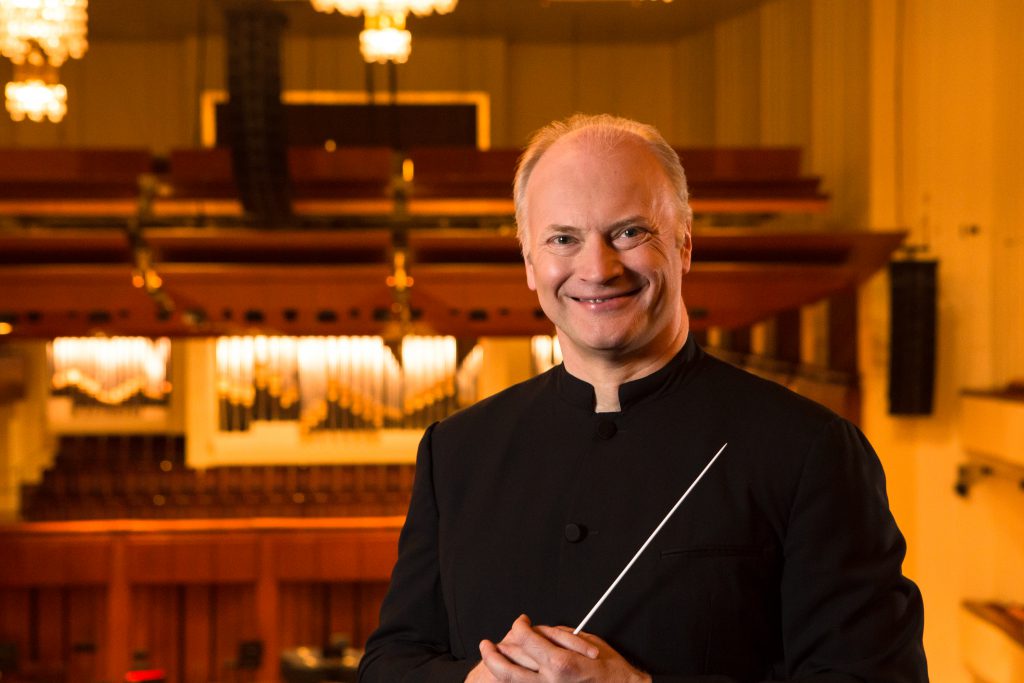Give thanks for blazing Rachmaninoff in Noseda’s mixed Philharmonic program

Gianandrea Noseda conducted the New York Philharmonic Wednesday night at David Geffen Hall. Photo: Tony Hitchcock
One would like to have heard the halftime pep talk conductor Gianandrea Noseda gave the New York Philharmonic Wednesday night.
Down five touchdowns after listless performances of music by Rimsky-Korsakov and Saint-Saëns, the team came back after intermission and won one for the Gipper with a thrilling performance of Rachmaninoff’s acerbic yet juicy Third Symphony.
For whatever reason—probably not an inspirational speech but a difference in rehearsal time—the Philharmonic played like two different orchestras on Wednesday. Woe to those audience members, like the one sitting next to this reviewer, who didn’t stick around for the second half. They missed what will likely be a top-ten performance of this Philharmonic season.
Like The Firebird, Rimsky-Korsakov’s opera The Legend of the Invisible City of Kitezh weaves a fairy tale of good and evil and magical intervention in human affairs. In fact, foreshadowings of that ballet by Rimsky-Korsakov’s pupil Stravinsky abound in the opera’s exotic or spooky moments, as organized into a suite by another pupil, Maximilian Steinberg.
In its fragmentary way, the suite follows the outline of the opera’s plot, and one might expect some sense of a narrative as it goes along. But Wednesday’s rather disjointed performance, with its ragged wind entrances and flat-footed rhythm, showed little sign of a shaping hand.
At first, the strings’ low-profile phrasing seemed meant to evoke the naïveté of a Russian folk song. But when everything, folksy or not, was played that way, virtue became a fault. Finally, in the closing “Ascension to the Invisible City,” which depicts the apotheosis of the opera’s two lovers, Wagnerian yearning phrases warmed up the strings a bit, but still didn’t give the narrative much of a push.
A Romantic solo concerto is a musical narrative without words, typically featuring a heroic protagonist in a drama of argument, reflection, and finally triumph. The Violin Concerto No. 3 by Saint-Saëns, composed for the legendary virtuoso Pablo de Sarasate, fills the bill nicely, with its blazing runs and arpeggios, heart-melting melodies, and wizardry of pizzicato, whistling harmonics, and more.
The Philharmonic’s concertmaster, Frank Huang, seemed miscast in the Sarasate role on Wednesday. The Spanish violinist, by all accounts, was among the most fiery and seductive players the instrument has ever seen. If those traits are part of Huang’s musical personality, he left them in his violin case Wednesday night. His earnest, proficient performance evoked not so much the charismatic virtuoso as the hardest-working kid in the conservatory.
One can hardly blame the concertmaster, after weeks and weeks of playing brief, lyrical solos in orchestral scores, for wanting to show that he can fire off a blistering scale with the best of them. And no question, his technique Wednesday night was a wow. But without some variety in tone color—beefing it up when needed, or sweetening it in tender moments—a performance can get stuck in neutral, and that’s what happened here.
Meanwhile, much of the time–and especially in the second movement, ambiguously marked Andantino quasi allegretto–the orchestra seemed to be waiting for a call that never came. Ironically, standing before them all, their leader failed to lead.
After intermission, all tentativeness was banished in the opening flourishes of the Rachmaninoff symphony. One knew right away that this would be another kind of ride, as violins dug deep, woodwinds flashed, percussion crackled, and it all came together in a rich yet crystalline brew of orchestral sound.
In this symphony, one of his last compositions, the 20th century’s arch-Romantic composer seemed to have outgrown his youthful long-windedness and reliance on big, gorgeous tunes to carry the piece, reveling instead in his compositional powers and sardonic wit.
At the work’s 1936 premiere and often since, listeners have lamented the departure of the dreamy young Rachmaninoff in favor of the clear-eyed old man, but Wednesday’s performance found fresh delights in every corner of the score, from the hallmark rat-a-tat rhythms that drove parts of every movement to the string phrases that swelled like distillations of the “big tunes” of yore, to all-hands-on-deck crescendos that seemed to shake the building.
Moments to savor included the first movement’s development section, in which Rachmaninoff indulged his love of expressive dissonance to the point where his friend, the composer Nikolai Medtner, worried that he’d gone over to the dark side of modernism; the fierce scherzo that broke out in the middle of the slow movement, popping and whistling like a fireworks show; and the finale’s sly fugue, which started academically enough but then took off in flights of fancy.
During the symphony, conductor Noseda was far more animated on the podium than earlier, punching the air and swooping encouragement to the players. Maybe that was all the pep talk they needed. In any case, the results spoke louder than words.
The program will be repeated 8 p.m. Friday and Saturday. nyphil.org; 212-875-5656.







Posted Nov 30, 2017 at 11:13 am by Geo.
Silly question, perhaps; in the first movement, did Noseda take the exposition repeat? My guess is ‘no’, but I’m hoping that he did.
Posted Dec 20, 2017 at 1:56 am by Sedgwick Clark
Yes, he took the repeat.